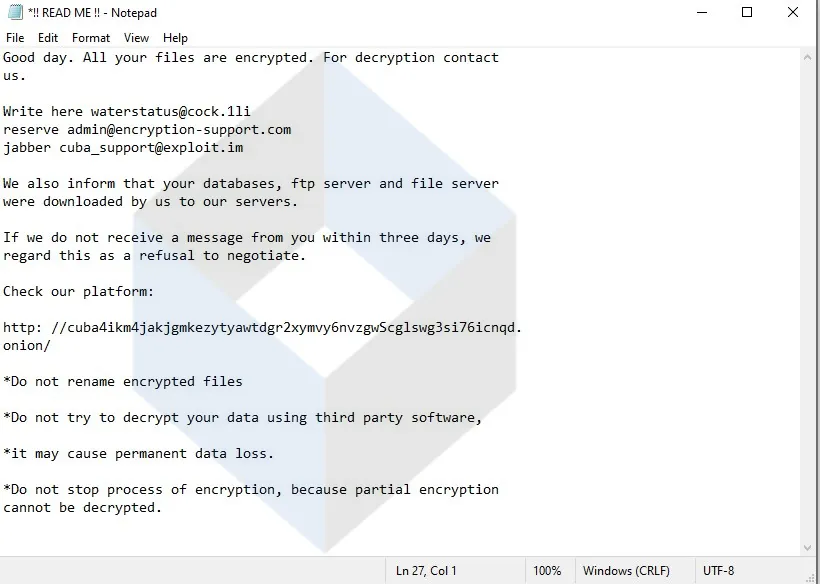
Table of Contents
ToggleIntroduction
In today’s digital landscape, protecting your website from cyber threats is important. Ransomware assaults, in particular, have emerged as a significant danger to enterprises worldwide. One such gang strain that has been wreaking havoc is the Cuba Gang. In this post, we will look into the complexities of Cuba Ransomware Group and its style of operation, as well as present you with practical ways to keep your company from becoming a victim of this risky gang. visit our services page Invaders. Take action now to safeguard your business!
Understanding Cuba Ransomware
Belongs to the category of malicious software specifically designed to encrypt files on a victim’s computer or network. This encryption renders the files inaccessible until a ransom is paid to the attackers. Similar to other group variants, Cuba commonly gains entry into a system through phishing emails, compromised websites, or the utilization of various malware delivery methods.[1]
The Threat Landscape: Cuba Ransomware’s Impact
Cuba Gang has wreaked havoc across various sectors, including healthcare, manufacturing, IT, government, and finance. According to the Federal Bureau of Investigation (FBI), the gang has extorted a staggering $43.9 million from victims, demonstrating their significant financial gains from these malicious activities [2]. The FBI has identified over 49 entities involved in critical infrastructure sectors that have fallen victim to Cuba attacks, highlighting the magnitude of the threat [2].

Tactics Employed by Cuba Ransomware
To gain initial access to a victim’s network, Cuba actors use a variety of techniques. Phishing emails, exploiting vulnerabilities in Microsoft Exchange servers, using compromised credentials, or using legitimate Remote Desktop Protocol (RDP) tools are examples. [3]. Once inside the network, the threat actors use legitimate tools found on Windows systems to spread the attack. [1].
Mitigating the Risk: Protecting Your Website from Cuba Gang
As a website owner, there are several crucial steps you can take to enhance your website’s security and protect it from Cuba attacks. Here are some key strategies to consider:
1. Prioritize Patching and Vulnerability Management
It is critical to keep your website’s software, plugins, and CMS up to date. Apply security patches and updates on a regular basis to address known vulnerabilities. Cybercriminals frequently exploit these flaws to gain unauthorised access to your website and install ransomware. [1].
2. Implement Robust Email Security Measures
Phishing emails are a common way for ransomware to infiltrate a system. Educate your users on how to identify and report phishing attempts. Implement anti-spam filters and email authentication protocols such as DMARC, SPF, and DKIM to reduce the risk of phishing emails reaching your users’ inboxes. [1].
3. Enforce Multi-Factor Authentication (MFA)
Setup and enforce multi-factor authentication for every account of users who have access to the backend of your website. MFA enhances security by requiring users to submit additional authentication factors, such as a one-time password or biometric verification, in addition to their credentials. [1].
4. Regularly Backup Your Website
It’s crucial to regularly backup the information and files on your website. Implement a reliable backup system that includes routine, automatic backups that are safely stored offshore. Having recent backups can help you restore your website to its pre-attack condition in the case of a ransomware attack, minimising data loss and disruption. [1].
5. Implement Network Segmentation
The lateral movement of ransomware inside your infrastructure may be prevented by segmenting your network into discrete zones. You can limit the effects of a possible ransomware outbreak and stop it from spreading to sensitive locations by segregating important systems from other network resources. [3].
6. Employ Endpoint Protection and Detection
Strong endpoint security solutions may be used to assist in detecting and thwarting ransomware assaults at the endpoint level. To recognise and eliminate such threats, use cutting-edge antivirus software, intrusion detection systems (IDS), and endpoint detection and response (EDR) solutions. [1].
Conclusion
As the security of the ecosystem evolves, company owners must be aware and proactive in protecting their online assets against Cuba ransomware assaults. You may dramatically lower the danger of falling prey to this deadly ransomware strain by establishing a complete security plan that includes frequent patching, email security measures, multi-factor authentication, backups, network segmentation, and endpoint protection. Stay educated, be prepared, and prioritise website security to protect your digital presence from the ever-increasing danger of ransomware.
Remember that securing your website is a continuous process, and staying current on the newest cybersecurity techniques is critical to having a secure online presence.
References
- CISA – #StopRansomware: Cuba Ransomware
- PCMag – FBI: Hackers Behind ‘Cuba’ Ransomware Have Earned at Least $43.9 Million
- CISA – #StopRansomware: Cuba Ransomware
- BleepingComputer – FBI: Cuba Ransomware Raked in $60 Million from Over 100 Victims
- BleepingComputer – Cuba Ransomware Returns to Extorting Victims with Updated Encryptor
- SOCRADAR – Dark Web Threat Profile: Cuba Ransomware Group
- Wired – Cuba Ransomware Gang Abused Microsoft Certificates to Sign Malware
- BleepingComputer – Hacker Uses New RAT Malware in Cuba Ransomware Attacks
- BankInfoSecurity – ‘Cuba’ Ransomware Gang Hits Payment Processor, Steals Data
- InfoSec Write-ups – Know Your Adversary: Cuba Ransomware
- Trend Micro – Ransomware Spotlight: Cuba
- BleepingComputer – Microsoft Exchange Servers Hacked to Deploy Cuba Ransomware



